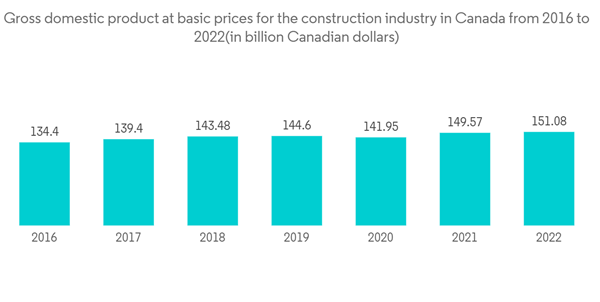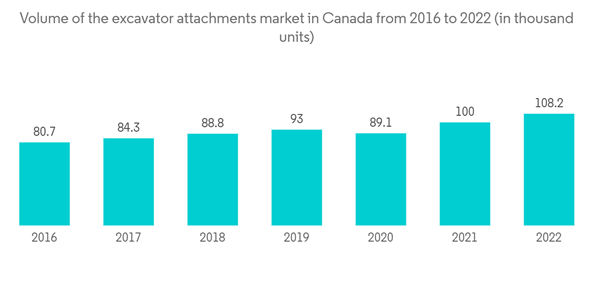Over the medium term, Canada is rich in natural resources, including oil, minerals, timber, and others. The extraction and processing of these resources often require construction equipment, which, in turn, is likely to enhance the demand for construction equipment in the coming years.
Also, as the urban areas in Canada continue to grow, there is a consistent need for residential, commercial, and industrial construction. This ongoing urbanization fuels the demand for construction equipment to build and maintain infrastructure.
The demand for cost-effective machines, with regulatory pressures for lower emissions, is pressurizing construction equipment manufacturers to opt for electric and hybrid vehicles over the traditional hydraulic and mechanical ones.
Major presence of construction equipment manufacturers such as SANY Heavy Machinery Canada Ltd., Liebherr Group, Wacker Neuson, Deere & Company, Kubota Canada Ltd., Komatsu, and Volvo Construction Equipment. Canada is investing in research and development. It is anticipated to boost the market during the forecast period. For instance,
In February 2022, Aecon, one of Canada's leading construction companies, is partnering with Volvo Construction Equipment to launch a second pilot project of electric heavy machinery on Ontario job sites. It is a sign that the industry is there and is growing interest in zero-emission equipment.
Canada Construction Equipment Market Trends
Growing Infrastructure development
The Canadian government effectively collaborated with provincial and territorial partners to allocate over USD 33 billion towards various projects nationwide. Canada's government commitment to infrastructure investment significantly boosted the demand for construction equipment.Investment in transportation projects, including road construction, bridges, and public transit systems, escalated the need for a wide range of construction equipment. Excavators, bulldozers, graders, and asphalt pavers are crucial in expanding and maintaining the transportation network. As the population grows and urbanization continues, the demand for efficient and well-maintained infrastructure remains high.
The continued expansion of the new home market implies that new homes are still being built, but mostly in locations where the market moves quickly. For instance, in March 2021, Canada's average home selling price increased by 31.6% Y-o-Y, setting a new high as sales rose to an all-time high.
The Rise in demolition activities in the country is likely to increase the demand for construction equipment during the forecast period. Furthermore, new initiatives from the governments to encourage the FDI inflow and favorable policies encouraging long-term investments in the respective countries are expected to further augment the growth of the market. It is simultaneously expected to increase the demand for construction equipment during the forecast period.
Growing demand for construction equipment across the country
In the forecasted period, cranes are anticipated to maintain a substantial market share within the Canadian construction machinery market. The ongoing trend of automating cranes remains prevalent in the Canadian market, with a primary focus on safety and operational efficiency, especially within the mining sector.Cranes are a vital necessity on nearly every construction site, serving the critical role of moving and depositing various construction materials. These versatile machines come in various sizes to accommodate different capacity and load needs. In response to growing demand and the desire to expand their market presence, manufacturers started introducing new products.
With the increasing demand for urban and rural population housing and rapid diversification of the region's businesses from the in-house giant oil and gas industry to tourism and other sectors, the demand for construction activities in the region is expected to rise over the forecast period.
Rising technological advancements and digitalization in construction equipment are anticipated to offer enormous growth in the construction equipment market during the forecast period. Moreover, growing product launches and innovations will further enhance the adoption of small mobile during the forecast period.
The cumulative growth in the renting business for loaders, especially in developing countries, fostered the demand in the target market. It is attributed to the real-time data, which helps the fleet owner manage the fleet and analyze the machine's health, fuel level, battery condition, and other critical parameters of their fleet on their mobile devices. It provides service reminders and the history of the machine. New wheel loaders with major advantages in terms of high power and efficiency are being introduced to the market to cater to the expected high demand from the construction sector, specifically for earthmoving applications. For instance,
- In March 2023, Liebherr presented its new mid-size wheel loader Xpower with increased performance. It is due to new lift arms, more engine power, and optimized travel drive.
Canada Construction Equipment Industry Overview
Major companies, such as Komatsu Ltd., Liebherr Group, J C Bamford Excavators Ltd., AB Volvo, and Others, dominate the Canadian construction equipment market. The major players in the market are focusing on improving their product portfolios to widen their customer base. Some other key players aim to expand their presence in the market through acquisitions, mergers, and collaborations with other companies. For instance,- In July 2023, North American Construction Group Ltd. made an official announcement regarding its definitive purchase and sale agreement to buy the MacKellar Group. It includes its heavy construction equipment fleet for an estimated sum of USD 395 million.
- In January 2023, Volvo Construction Equipment (Volvo CE) introduced its Collision Mitigation System for Volvo Wheel Loaders. This automatic braking feature supports operator response and helps to reduce the risk or consequences of collision when working in reverse.
Additional Benefits:
- The market estimate (ME) sheet in Excel format
- 3 months of analyst support
This product will be delivered within 2 business days.










